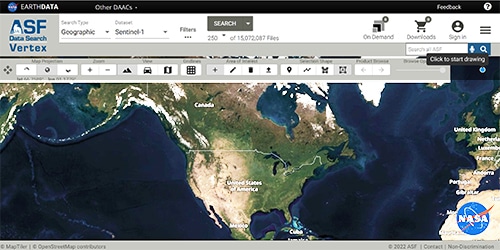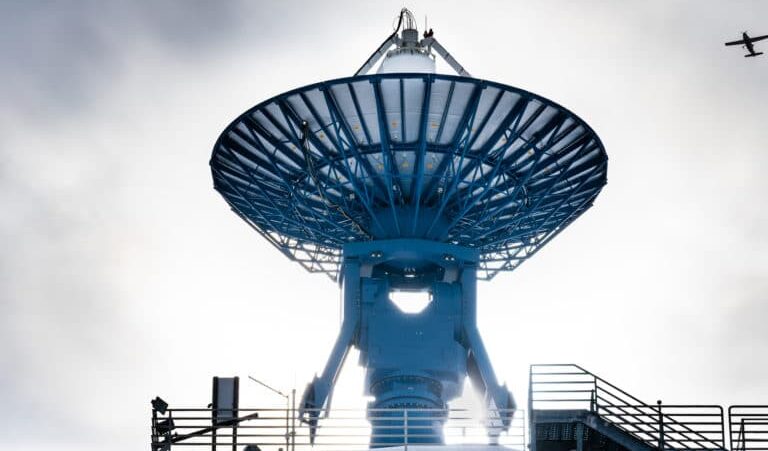Glacier Power Glossary
Ablation, Ablation zone
Processes (especially melting) by which a glacier loses ice and snow: melting, evaporation, calving, and erosion. The area of a glacier where ablation occurs.
Accumulation, Accumulation zone
Process (especially snowfall and compression) by which a glacier gains snow and ice. The area of a glacier where accumulation occurs.
Arete
Sharp, narrow ridges formed on a mountain by a glacier.
Basal Slip
The sliding of a glacier over its bed.
Bedrock
The solid rock under a glacier or ice sheet.
Boulder
Also called, “erratic boulder.” Large boulders are sometimes left behind when a glacier recedes or retreats.

Calving
Glaciers calve icebergs, which are chunks of ice that break off glaciers and fall into water.
Cirque
A bowl or basin carved out of a mountain by a young glacier.
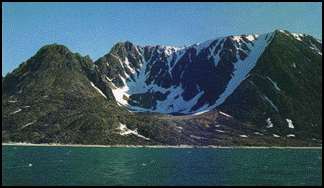
Crevasse
An open crack in the glacier surface. (See also Types of Crevasses).
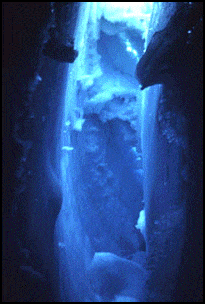
Compression
To make more compact, press together into less volume or space.
Debris
Geology: An accumulation of relatively large rock fragments: glacial debris.
Discharge
To let go; to empty out; to pour forth.
Drumlin
Smooth rounded mounds of glacial till (rock, dirt, and debris) deposited under a glacier.
ERS-1
European Remote Sensing Satellite-1.
Firn
Rounded and compact snow that is older than one year.
Fjords
Deep U-shaped coastal valleys, originally eroded by a glacier but now filled by the sea. Some fjords still contain a glacier.
Folia/Foliations
Individual layers or bands of ice crystals produced during the metamorphic process that changes snow to glacier ice.
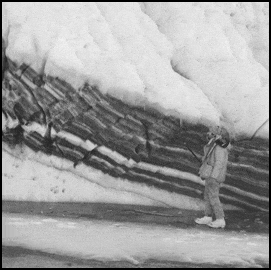
Glacier
A large accumulation of many years of snow, ice, rock, sediment and water that originates on land and moves down slope under the influence of its own weight and gravity.
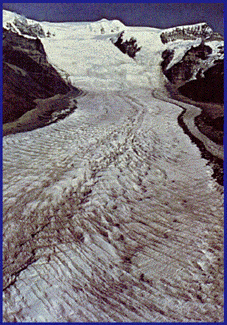
Glacier Flour
The very finely ground particles of rock, silt, or clay created by a glacier when its rock-filled ice scrapes over bedrock and which flow out from beneath a glacier in the meltwater.
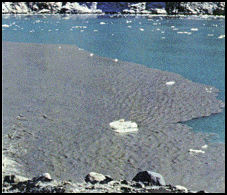
Glacier Table
A boulder sitting on a pedestal of ice. The boulder protects the ice from melting during sunny weather.
Hanging Glacier
A glacier that spills out from a high level cirque or clings to a steep mountainside.
Horns
Steep-sided peaks, shaped like pyramids, formed when cirque glaciers erode on three or more sides of a mountain.
Ice Ages
A time when large sheets of ice covered a large amount of the earth because of cooler temperatures.
Ice Apron
A steep mass of ice that clings to steep rock at the summits of high peaks. (A common source of ice avalanches.)
Iceberg
See “Calving“.
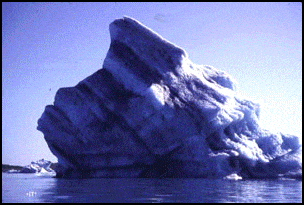
Ice Cap
A steep mass of ice that clings to high peaks.
Ice Fall
Jumbled and broken ice which forms when a glacier flows over a steep drop-off.
Ice Sizzle
A crackling or sizzling sound, similar to soda or Rice Krispies, that is produced by an iceberg while it is melting. The sound is caused by the release of air bubbles that were trapped in the glacier ice during its formation under high pressure. This is also called “bergy seltzer.”
Ice Stream
A stream of ice flowing down-valley.
Ice Tongue
A floating extension of an ice stream or valley glacier projecting into the sea.
Ice Worm
Ice worms are the only earthworms known to inhabit snow and ice. They thrive in temperatures just above freezing.
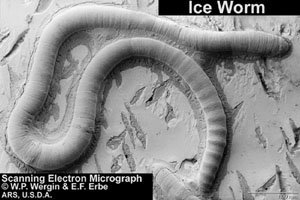
Interglacials
The relatively warmer periods between each ice age when the ice sheets retreat.
Isostatic rebound
Land that was once pushed down by the heavy weight of glacial ice may experience actual rising at the small rate of about a centimeter per year after the ice melts away.
Jokulhlaup
(Outburst Flood) A tremendous release of water that was trapped behind a glacier or underneath a glacier.
Kame
Steep-sided hills of sand and gravel deposited by glacial streams or in crevasses.
Kettle
The result of a very large block of ice being left behind as a glacier recedes. The melting forms potholes which are sometimes filled with water in a glacier, till, or outwash plain. Vegetation may grow up around kettles.
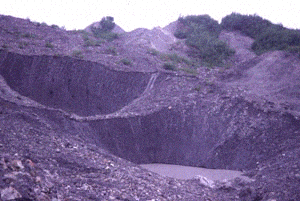
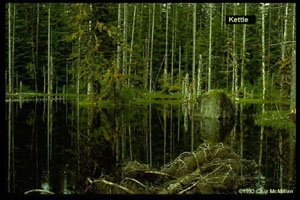
Lateral Moraine
A large mass of glacial material on the sides of a glacier.
Mass Balance
The difference between the amount of material that a glacier accumulates and the amount lost during ablation is called its mass balance. The equilibrium line moves down or up a glacier as the mass balance changes.
Medial Moraine
A central moraine formed where two glaciers join to form a large glacier.
Meltwater
Water produced by melting glacier ice, firn, and surface snow. Meltwater flows down the bed of the glacier and emerges from the end as a stream often colored gray-green by the rock flour it contains.
Metamorphic
Something that undergoes changes in structure or composition, texture, or internal structure by (for glaciers) heat or pressure.
Moraine
A glacial deposit of rocks and debris that forms through direct action or contact with glacier ice.
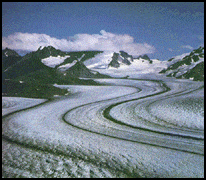
Moulin
A hole or tube in a glacier into which water flows. Moulin is French for mill, so called because of the loud, roaring noise made by the falling water.
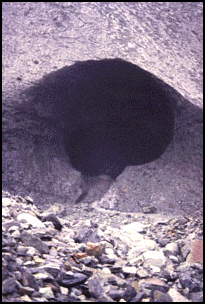
Neve
The area of a glacier covered with snow throughout the year.
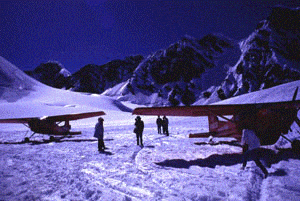
Nunatak
Mountain peaks or ridges which poke through the ice, forming islands within the glacier.
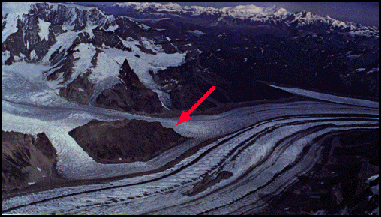
Ogives
Repeated curved bands created within glaciers at the base of ice falls.
Outwash Plain
A broad, gentle plain composed of sand and gravel washed out of a glacier and deposited by meltwater streams.
Piedmont Glaciers
The parts of glaciers, fed by mountain glaciers, that have spread out over broad lowlands.
Rock Flour
Same as “Glacier Flour.”
SAR
Synthetic Aperture Radar can “see” through clouds and can “see” in the dark like a bat! SAR is a microwave radar used to penetrate through clouds or darkness to obtain images of the earth.
Snow
Frozen precipitation in the form of white or translucent six-sided ice crystals that fall in soft, white flakes.

Snowflake
A single flake or crystal of snow.
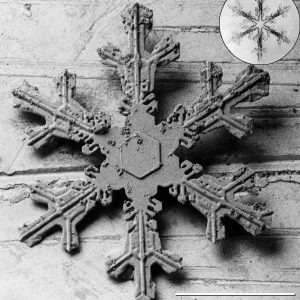
Surge
A short period when a glacier can go as much as one hundred times faster that it normally goes. This happens when a glacier slides downstream on water trapped beneath it.
Surge Front
The leading edge of the wave or bulge of moving ice which represents the surge before it reaches the terminus of the glacier.
Tarn
A small lake filling a hollow which was eroded out by ice or dammed by a moraine. Frequently found with cirques.
Terminus
The snout, end, or leading edge of a glacier.
Tidewater Glacier
A glacier that ends in the sea.
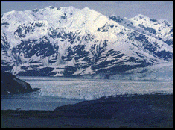
Till
The rock, dirt, and debris deposited beneath a glacier.
Valley Glacier
A glacier which flows from a high mountain, from an ice cap, or from an ice sheet into a valley.
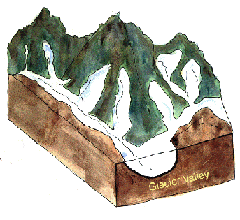
Watershed
The region draining into a river, river system, or other body of water.


